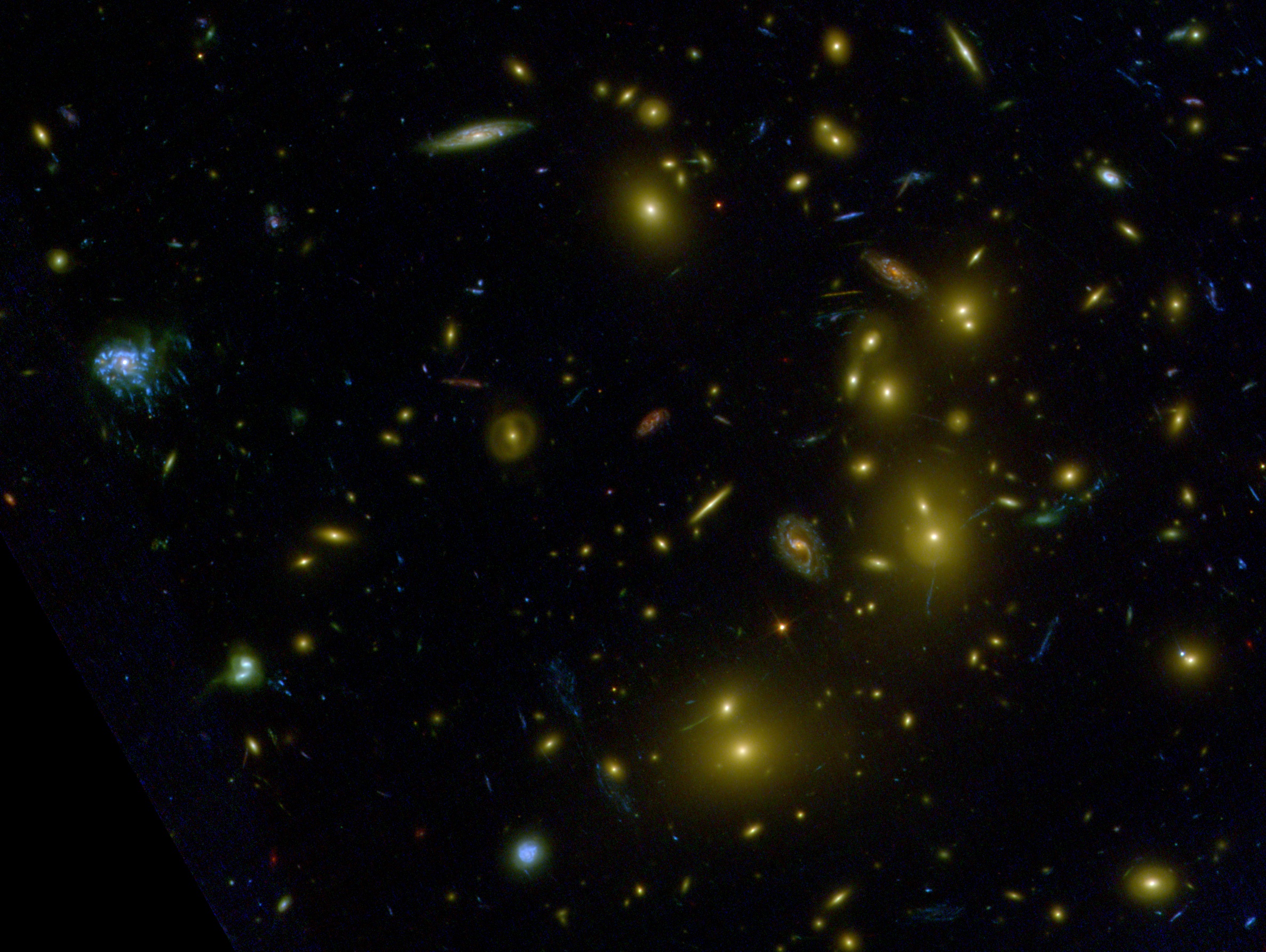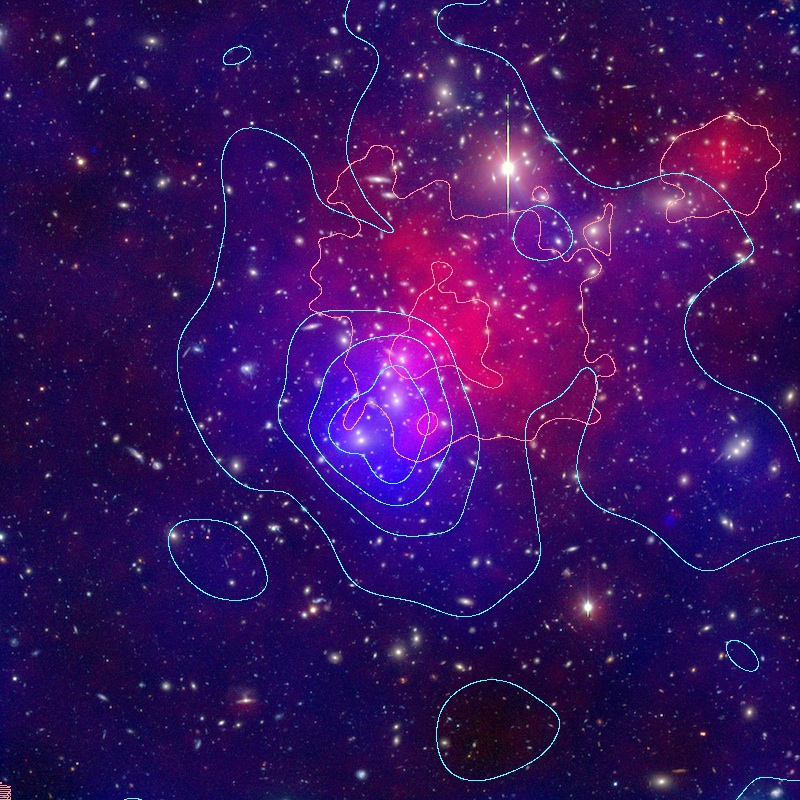Selected
Research Projects
|
Intracluster Gas Dynamics Direct Methods - ICM Bulk Motions Clusters of galaxies are the largest
gravitationally bound systems in the universe, containing 102-3
galaxies and also large amounts of hot (107-8 K) X-ray
emitting intergalactic gas confined by the gravitational potential of
the system. The X-ray emitting gas makes up the largest baryonic
component in these systems (>80%). Currently favored
cosmological models involve the “bottom-up” scenario for large-scale
structure formation. The formation of galaxy clusters is then due to
the continuous accretion of smaller systems. One of the consequences of
this formation process is the production of intracluster
gas bulk flows, transitory or rotational. I am leading a project to measure directly
these bulk flows using the Doppler shift of the lines in the X-ray
spectra of clusters. The initial results with ASCA revealed a strong
velocity component (1-2 × 103 km/s)
in a relatively high fraction (~5%-10%) of the sample, including the
nearby Perseus and Centaurus
clusters.
My research currently has expanded to include
archival and new Chandra and XMM-Newton satellites. The results imply
that a significant fraction of the total merger
energy in some cases may still be kinetic more than 0.4 Gyr after the last merging event and also that
even strong mergers may not show strong signs of turmoil in the
projected temperature or density structure despite the energetics involved (1063-64
ergs). One of the clusters Abell
576 analyzed recently with both Chandra and XMM-Newton has the
characteristics of a high velocity impact (>3300 km/s) in the
line-of-sight, similar to the “bullet” cluster turned 90˚ towards the
observer. For a press release click here. Using the typical masses and bulk velocities
values currently observed, the ratio of bulk kinetic to gravitational
energies in cluster’s central regions can be more than 5 times higher
the typical currently desired/achievable level for cosmological use. Indirect Methods, Cold Fronts, Dark Matter
Detection - Cluster-cluster/group mergers are the most
energetic events in the universe. When they happen near the plane of
the sky, they produce several observable features that allow us to
infer the dynamics of the intracluster
gas, such as shock fronts, and also to determine the properties of dark
matter (e.g. the bullet cluster). A
puzzling intracluster gas feature
discovered after the launch of Chandra is the so-called “cold front”,
which is a sharp surface brightness discontinuities characterized by a
jump in temperature, maintaining the gas pressure continuous across the
front. The most popular explanation for cold fronts is associated with
subsonic or transonic motions of accreted substructures (Markevitch et al. 2000, 2001) such as gas clumps
or small galaxy groups (figure below-left). This mechanism does well
for the more typical cases of cold fronts where the clusters do not
exhibit signs of strong mergers such as Abell
496.
My research has shown that
alternative mechanisms such as gas sloshing due to off-center passages
of pure dark matter clumps as modeled by Ascasibar
& Markevitch (2006) match well the
observations, and we have verified specific model predictions such as
cold spiral X-ray arms in Abell 496
(below).
Virtual Cluster Exploratory - I am Co-investigator (PI: Gus Evrard) on a project to develop a Virtual
Observatory (VCE) to compare virtual galaxy clusters,
extracted from cosmological simulations to real ones, helping to zero
in on the correct ICM models and test different cosmological recipes. A recently completed VCE project was focused
on determining the expected distribution of clusters with velocity
gradients (Pawl, Evrard & Dupke 2005).
One of the results from this work was that the maximum velocity
differences ΔV/cs in clusters
fall as (ΔV/cs)-4
(Figure below).
This indicates that the detections that we found with ASCA,
Chandra and XMM-Newton maybe just the “tip of the iceberg”, with
many more clusters expected to have intermediate (~700-1000) km/s)
residual velocity gradients.
Missing Baryons in the Local Universe: One of the current mysteries that has drawn a
significant amount of attention is the fact that stars and gas in galaxies in the local
universe accounts for only for a small fraction (<20%) of the
baryonic mass (Fukugita & Peebles 2004;
Danforth & Schull
2005; Nicastro et al. 2005). This is
typically denoted as the “missing” baryon problem, which has drawn much
attention, and the current leading solution is that most of the gas has
remained in the gas phase (Fukugita, Hogan,
and Peebles 1998; Cen and Ostriker 1999). However, since the Lyα forest in the local universe
is small, accounting for ~29% of the baryon content (Penton et al. 2004; Sembach
et al. 2004), a significant fraction of the gas must be in a warm-hot (>
105 K) phase (Cen and Ostriker 1999; Dave et al. 1999, Cen et al. 2001), which has
evaded direct detection so far. Although these filaments are too diffuse and
cold to be directly observed by current X-ray telescopes, they can be
detected indirectly using absorption lines of background AGNs. Cosmological simulations indicate that
these cosmic filaments would be most prominent in superclusters
of galaxies. In an initial pilot study of archived HST and FUSE AGN
data, we found three AGNs located behind
the lines connecting clusters in superclusters
that could be used to detect the Cosmic Web (Bregman, Dupke & Miller 2004), and one of them shown below. We are now
carrying out a larger follow-up project to establish the detection of the cosmic filaments with better
statistics in order to determine the characteristics of the filaments
and explain the local baryon budget deficit using HST (for Lya) and FUSE (to get Lyb and OVI lines) and Sloan Digital Sky Survey,
Las Campanas
redshift survey and ROSAT North Ecliptic Pole Survey to locate superclusters. The
latter (NEP Supercluster) has recently
been approved to us for observation with the FUSE
satellite.
Fossil Groups - Fossil groups are galaxy systems that present
an unusual lack of bright galaxies in the inner regions, except for of
a giant central E galaxy. Recent measurements of galaxy velocity
dispersion in fossil groups are consistent with the dynamical state of
the system as determined from X-ray observations. This indicates that
they have relatively deep gravitational potential wells, more typical
of clusters. The popular mechanism proposed to "wipe out" the big
galaxies surrounding the central dominant galaxy is still cannibalism.
If so, and if the galaxy population is heterogeneous, strong galactic
winds resulting from galaxy merging might be trapped by their deep
potential wells destroying the central enhancement of SN Ia/SN II ejecta
ratio typically seen in other galaxy groups. I have started testing
this prediction by looking at the distribution of metal abundance
ratios near the core of a sample of fossil groups. Initial results
shows an enhancement of SN II ejecta near
the core of some fossil groups, where the available data allows for
such analysis. Discrimination between SN
Explosion Mechanisms: The
presence of gradients of the ratio of individual elemental abundances
in the ICM allows the opportunity to test the theoretical explosion
models for SN Ia. I pioneered this
technique and tested it using the Ni/Fe ratio to compare the two most
favored models for SN Ia explosion: the W7
“deflagration” model and the “delayed detonation” models (Dupke &
White 2000, Dupke & Arnaud 2001). These
models differ in the characteristics of the propagation front and,
consequently, in the nucleosynthetic
yields for different elements. The results so far do not favor the
delayed detonation explosion models. The improvement of the spectral
resolution of X-ray spectrometers will soon allow the same technique to
be applied with other abundance ratios and it is expected that it will
provide a diagnostic for testing further SN explosion models. |











